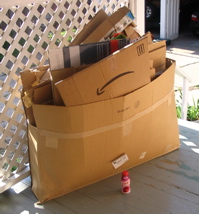 It all started back in the 1890s. Catalogues came to farmers. Farmers sent their money. Good arrived in boxes. Those goods — everything from watches to carriages to entire houses in kits — came from Sears, Roebuck and Company. The goods were often things that couldn’t be bought locally at reasonable prices or with a reasonable selection and Sears et al was able to earn business by offering greater selection at lower prices with free delivery. I’m not sure what the farmers did with their Sear’s boxes. Probably reused them for something, but… but eventually I’m guessing most of them found their way into the garbage pile along with the rest of the packing materials.
It all started back in the 1890s. Catalogues came to farmers. Farmers sent their money. Good arrived in boxes. Those goods — everything from watches to carriages to entire houses in kits — came from Sears, Roebuck and Company. The goods were often things that couldn’t be bought locally at reasonable prices or with a reasonable selection and Sears et al was able to earn business by offering greater selection at lower prices with free delivery. I’m not sure what the farmers did with their Sear’s boxes. Probably reused them for something, but… but eventually I’m guessing most of them found their way into the garbage pile along with the rest of the packing materials.
Right now there is a box of boxes on my back stoop that is human-sized in volume, and almost human massed (see picture: note single serving Silk yogurt for scale). It is the result of shopping online where the selection is higher, the prices are often lower, and sometimes there is free delivery. Amazon, Drs. Foster and Smith, and eBay are all to blame. As much as I hate the mega-malls, the strip malls, and, well, even the local mall, I have to wonder if their isn’t a more eco-friendly way to purchase the things that can’t be acquired on a walk through the mom and pop stores of main street?
Paper is not an inherently bad product. In fact, the fast growing trees that are used to make domestically grown papers are good for the environment. Given the choice of paper or plastic, paper may be the more sound option – If the paper bag blows away and get wet, it turns to mush. That plastic bag is just going to blow free, waiting to get stuck in a tree, wrap itself around an animal, get chocked on by an animal, or otherwise do something bad. Similarly, cardboard boxes are something I can bury in my garden under a layer of bark mulch and know that (assuming I remove all the tape and staples) they will decay to worm food after one weed blocking season. The plastic just keeps blocking the weeds on and on and on.
The real problem with our catalogue ordering, Amazon clicking, box filled society is that we are consuming far more resources than are necessary. There have been days when the UPS dud has come to our house twice and the DHL and FedEx guys have each taken their turns as well. That’s a lot of gas, a lot of plastic filling materials, and a lot of cardboard all used to bring use a few objects that would all have fit in one backpack. Particularly troubling is the addiction to 2-day air mail that comes with our Amazon Prime membership. Every planeload of wares is a major insult to the environment – but our household desire for instant gratification keeps those planes flying.
Environmentally responsible shopping requires one to buy locally grown and manufactured goods that preferably come from environmentally responsible companies. Like the Tuscans, we should learn to eat what is in season, and savor the favorite foods of the current crop rather than demanding out-of-season apples in May. Unfortunately, our centralized economy has largely adapted to our generic unchanging needs, so soybeans for cows come from where I live, and soybeans for people come from Wisconsin, while non-soy food comes from somewhere else. Instead of growing everything everywhere, we grow something somewhere and ship it everywhere. This process has its own efficiencies, but it unbalances ecosystems, makes entire crop destruction possible with one foul storm, and keeps lots of long haul shippers employed when their spouces would likely live it if they just did a daily dairy run.
When Wal-Mart and the other big box companies (who require centralized production to get the needed amounts of inventory) put mom and pop stores out of business, they are also ruining the environment by feeding out “Everything now” mentality.
Not that I help the environment when I order my garden plants and compost bin from the web — there are ironies in the environmental movement.
So, having stared at my personal cardboard box pile and contemplated my environmental fingerprint, I’m going to pledge to myself that I will try to spend $1 in a local store with local products for every $1 I spend online, and I’m going to swear off air freight (at least until Harry Potter comes out…).
One small step at a time, maybe we can all reduce our environmental finger print or at least the amount of mass that goes through the mail.



My wife and I are going to Barnes & Noble for the midnight release of Harry Potter. So on the one hand we won’t have a box and packing material coming our way, but on the other hand we have to drive 45 minutes to get to the nearest Barnes & Noble. As would say…argh!
I wouldn’t worry too much about the cardboard as long as you recycle. Even the plastic isn’t that bad when you recycle. I have to admit that I’m not as worried about being “green” as most folks are these days. I’m not convinced the science being used to support global warming is not at least a little skewed by the the agenda of those presenting it (read United Nations).
Either way, I would say the more important problem that you have hit on here is that of Americas absolute need to instant gratification. If Americans would mature enough to free themselves from the prison of instant gratification many of the problems that plague our society would start to solve themselves: abortion, environmental problems, fuel prices, urban crime, etc.
I order a router from the US because they don’t have it in europe… I select USPS’s slowest delivery option of 5-14 days and it got here in 5 days.
The router came packed in small pastic bags, that where put in a white cardboard box, that was wrapped in a shiny cardboard box, which was shrink wrapped. This was then put in a larger box and news papers where stuffed around it for protection. That box was also sealed with plastic shrink wrapped.
When the box arrived the belgium post put it in another cardboard box with a plastic sealing coat (yay) because it had to go to customes… where the platic seal was broken the content was checked (only the box in it) and it was released with that irritating white tape with the little fibers in it.
… I think we need to stop over packing.
The standard linksys packaging would have been ok with a sticker with the adress on it.
Only thing that needs to be changed is that the truck, plane, truck, smaller truck have better padding inside so the boxes don’t get smashed crushed…
Ok I’m done ranting now.
I find most toys are extremely over-packaged as well. I can’t deny my kids toys obviously, it’s not their fault. However it takes about 1 minute to put the packaging in trash bags, the toys in a pile next to them, and ask what doesn’t make much sense about this comparison. Maybe if they can SEE it now they will continue to, unlike their mother who couldn’t(or wouldn’t) till age 25.
My husband got me some MagneStix for Christmas. This first little box contained about 50 pieces and build very little. More pieces were needed, so we went to Target and bought out their entire on-sale inventory and reaped a bounty of about 200 little magnetic sticks. The all fit in popcorn bowl. The packaging to get our loot home took up about 2 cubic feet.
Your observation is right on the money!
I really like that you show your kid the toys versus garbage ratio. I really respect that and will mention what you do to the mothers and soon-to-be moms in my life.
I was surfing the internet Monday afternoon during my break, and found your blog by searching MSN for grow a box. This is a topic I have great interest in, and follow it closely. I liked your insight on Death by a 1000 paper boxes- by Pamela L. Gay very much, but I don\’t quite aggree with everything you said. However it is still good reading, and makes some good points. Keep up the good work…